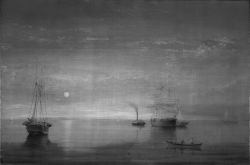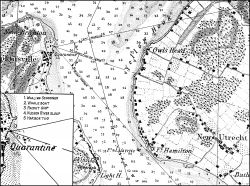loading 
Fitz Henry Lane
HISTORICAL ARCHIVE • CATALOGUE RAISONNÉ • EDUCATIONAL RESOURCE
An online project under the direction of the CAPE ANN MUSEUM
An online project under the direction of the CAPE ANN MUSEUM
Catalog entry
inv. 6
A Calm Sea
c. 1860 Oil on canvas 24 x 26 1/4 in. (61 x 66.7 cm) No inscription found
|
Supplementary Images
Provenance (Information known to date; research ongoing.)
the Artist, Gloucester, Mass.
Captain Obadiah Woodbury, Gloucester, Mass.
Alice Pattillo Woodbury, Gloucester, Mass.
Cape Ann Museum, Gloucester, Mass., December 1932
Exhibition History
Cape Ann Historical Association, Gloucester, Massachusetts, Training the Eye and Hand: Fitz Hugh Lane and Nineteenth Century American Drawing Books, September 17, 1993–January 29, 1994.
Published References
Wilmerding, John. Fitz Hugh Lane, 1804–1865: American Marine Painter. Salem, MA: The Essex Institute, 1964., p. 38.
The American Neptune, Pictorial Supplement VII: A Selection of Marine Paintings by Fitz Hugh Lane, 1804–1865. Salem, MA: The American Neptune, 1965., pl. XV, no. 83. ⇒ includes  text
text
Worley, Sharon. "Fitz Hugh Lane and the Legacy of the Codfish Aristocracy." Historical Journal of Massachusetts 32, no. 1 (Winter 2004)., p. 72. ⇒ includes  text
text


Commentary
With the sun rising over a large bay, three vessels lie at anchor in the fore- and middle grounds. At left, a whaling schooner awaits the return of one of her whaleboats, the double-ended boat in the foreground with two men rowing while a third steers—the only movement in this calm scene. At right, a large packet ship awaits a tugboat to bring her to her berth for unloading. A merchant sloop lies alongside. In the background, another merchant ship, a brig, and other smaller vessels are faintly visible. Beyond them lies a shoreline with a low profile and subtle contours.
The evidence that A Calm Sea depicts New York Bay is compelling. The tugboat and packet are very similar to those in a much larger depiction of New York Harbor by Lane: New York Harbor, c.1855 (inv. 46). The sloop alongside the packet shows hull characteristics and a color scheme very common to Hudson River sloops. All are vessel types that are intimately—even uniquely—connected to that port and that period. The tugboat, then termed a steam propeller (for its screw propulsion in place of paddle wheels), was to be seen only in New York Harbor in this period.
The low background topography corresponds to Long Island’s west end, running south from Flatbush to Fort Hamilton. A contemporary chart has permitted a reconstruction of Lane's viewing point, which was probably on the northeast shore of Staten Island, just above the quarantine hospital at Tompkinsville, looking a few degrees south of due east. (See map below.)
Proximity to the quarantine hospital would explain why a whaler and a packet (presumably inbound) would be anchored here and not tied up at wharfside. The packet has presumably cleared quarantine, hence is off-loading some trade goods to the sloop while awaiting the tugboat. Quarantine would have been necessary for the whaler if she had stopped at a foreign port (presumably the Azores).
There is one anomalous feature in this vessel: two whaleboats, indicated by two pairs of davits on the starboard (right-hand) side. The after boat, absent from the davits, is presumably the one in the foreground. In place of the forward boat, there was normally a gangway for cutting-in the whale and boarding the blanket piece (blubber). No davits were used in this process, the blanket piece being hauled up and inboard with a heavy cutting-in tackle rigged from the masts. Lane was not apt to make a mistake of this magnitude, leading to the possibility (and only a possibility!) that the owners of whaling vessels from the New York area had ideas of their own for the arrangement of boats and gear.
The calm water and diffused light of the sun rising out of a humid horizon creates the feeling of suspended time and deep space that is characteristic of Lane’s mature work. The subject here is the light and atmosphere of a particular time of day and place. The boats are incidental characters positioned to lead the eye down the sun’s reflected path across the harbor. The blue and yellow tonality of the sky arches over the predominantly red highlights of the vessels and the greens of the water, a subtle use of complementary colors.
Compared to Lane’s other New York and Boston Harbor views, this example does not have the taut organization necessitated by the greater number of vessels that appear in most of those works. The painting employs the same central shaft of the sun’s reflection on the water to lead one deep into the harbor space and to impart this sense of tranquility and arrested time to a harbor still half-asleep. A Calm Sea was painted on commission from Captain Obadiah Woodbury (1784–1873).
– Erik Ronnberg and Sam Holdsworth